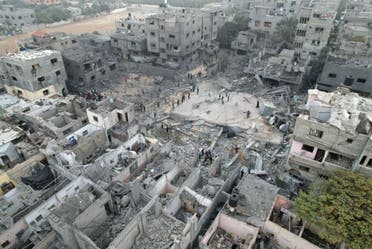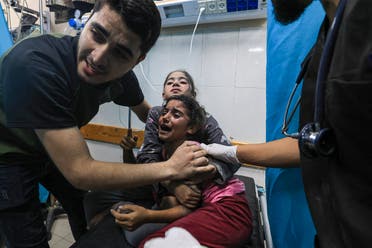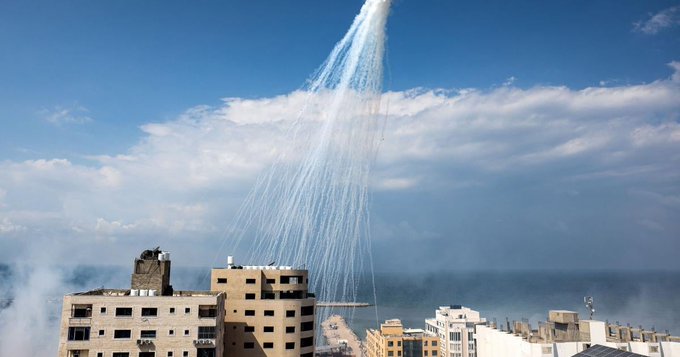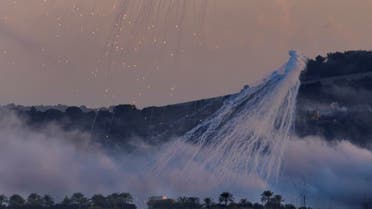Explainer: What are the phosphorus bombs that Israel is accused of using on Gaza?
Phosphorus bombs, known as white phosphorus (WP) bombs, are incendiary munitions designed to produce intense heat and smoke upon detonation.
“We have geolocated and verified videos that show artillery shells being airbursted over Gaza and over Lebanon, deploying white phosphorus… Donatella Rovera,
The UK-based human rights organization Amnesty International and Human Rights Watch in New York have accused Israel of using phosphorus bombs during its military operations in Gaza, putting millions of civilians at risk for severe and long-term injuries.
Israel has ruthlessly bombarded the Gaza Strip, killing more than 9,000 people, in what it says is a retaliatory attack on Hamas for the deadly October 7 in which 1,400 Israelis died and around 300 others were kidnapped.
But what sets phosphorus bombs apart from other rockets used by Israel in its war on Gaza? How have human rights organizations responded to their use, and is it considered a potential war crime?
Al Arabiya English breaks down all the facts about the incendiary weapons.
What are phosphorus bombs?
Phosphorus bombs, known as white phosphorus (WP) bombs, are incendiary munitions designed to produce intense heat and smoke upon detonation.
They have been used in various military conflicts for several purposes, including creating smoke screens, obscuring visibility, and destroying targets through fire. They can also be used as a weapon to set fires that burn people or objects.
They contain white phosphorus, a chemical substance that ignites when exposed to atmospheric oxygen and continues to burn until it is deprived of oxygen or exhausted.
Those particles are dispersed into surrounding areas, generating intense heat, light, and white smoke.
Upon contact, white phosphorus can burn people, both thermally and chemically, down to the bone.
Even after treatment, white phosphorus fragments can exacerbate wounds and enter the bloodstream, causing multiple organ failure.

Already dressed wounds can reignite when dressings are removed, and the wounds are re-exposed to oxygen, making even relatively minor burns fatal.
For survivors, extensive scarring tightens muscle tissue and creates physical disabilities.
Additionally, the trauma of the attack, the painful treatment that follows, and appearance-changing scars lead to psychological harm and social exclusion.
Why have human rights groups accused Israel of using phosphorus bombs?
On November 2, Amnesty International confirmed that Israel used white phosphorus munitions in the Gaza Strip and Lebanon.
“We have geolocated and verified videos that show artillery shells being airbursted over Gaza and over Lebanon, deploying white phosphorus… The evidence is quite incontrovertible,” the organization’s Senior Crisis Response Advisor, Donatella Rovera, told Sky News.
Earlier on October 12, Human Rights Watch had said it verified videos taken in Lebanon and Gaza on October 10 and 11 that show multiple airbursts of artillery-fired white phosphorus over the Gaza City port and two rural locations along the Israel-Lebanon border.
The organization also spoke to sources in Gaza who described the attacks. The sources said they saw explosions in the sky followed by white lines going downwards, according to a statement on the organization’s website.
The sources described the smell as “stifling,” with one person saying that the smell was so strong that he went toward the window to see what was happening and then filmed the strike, the statement said.
Human Rights Watch reviewed the video and verified that it was taken in Gaza City’s port and identified that the munitions used in the strike were airburst 155mm white phosphorus artillery projectiles. Other videos posted to social media and verified by Human Rights Watch show the same location with dense white smoke which is a characteristic of white phosphorus.
Human Rights Watch also reviewed videos from October 10 from two locations near the Israel-Lebanon border which show 155mm white phosphorus artillery projectiles being used.
Is the use of phosphorus bombs against international humanitarian law?
The use of phosphorus bombs is subject to international laws and regulations, especially when it comes to their use in populated areas or on civilians.
Several international agreements and protocols, such as the Geneva Conventions, prohibit the use of incendiary weapons, including phosphorus bombs, in certain situations to protect civilians and minimize unnecessary suffering.

According to Human Rights Watch, the use of white phosphorus in Gaza – where about 2.3 million people have been forced to live in a narrow, 40-kilometer stretch of land –violates the requirement of those international humanitarian laws that call for all precautions to be taken to avoid civilian injury and death.
“Any time that white phosphorus is used in crowded civilian areas, it poses a high risk of excruciating burns and lifelong suffering,” Lama Fakih, Middle East and North Africa director at Human Rights Watch, said in a statement.
“White phosphorous is unlawfully indiscriminate when airburst in populated urban areas, where it can burn down houses and cause egregious harm to civilians.”
According to Amnesty International’s Rovera, Israel has been carrying out “indiscriminate and disproportionate bombardments that have killed thousands of children.”
“It is quite scandalous to see the inaction of the international community in the face of a catastrophe, of a humanitarian crisis of these dimensions,” Rovera stressed.
“It is among the most intense and lethal conflicts we’ve seen in recent times,” she added.
Human Rights Watch’s Fakih called on Israel to stop using white phosphorus in populated areas, saying: “Parties to the conflict should be doing everything they can to spare civilians from further suffering.”


